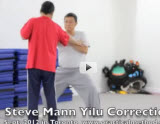 |
Chen-Style Tai Chi Practical Method (陈式太极拳实用拳法) is a unique martial art with a lineage tracing back to Master Chen FaKe (陳發科 1887-1957) and Master Hong Junsheng (洪均生 1907-1996). Over time, this style has developed specialized terminology and nomenclature to convey its principles and training methods. Master Chen Zhonghua (陈中华 1961– ), drawing upon decades of teaching experience and professional training in linguistics, introduces these terms to a Western audience. The following definitions clarify key terms used within the Practical Method.
Translation of Master Chen Zhonghua list of definitions in the Practical Method in 2012 (In Chinese only) |
Practical Method Rules List 2012 (translated)
Definitions (定义)
Tai Chi (太极拳)
A martial art that generates force through the body’s structure and subtle movements, with a focus on internal adjustments. ( 太极拳:用身体的肢体结构和微小的动作制造力的拳种。强调自身的内调整。)
Yin and Yang (阴阳)
Yin and yang represent opposing and complementary forces in Chinese philosophy. Things do not inherently possess yin or yang; they are differentiated through action. Both exist simultaneously within the same entity, resulting from movement rather than static states. (阴阳:万物本身并没有阴阳。是动作“分”出的阴阳。阴阳是发生在同一事物上的,是同时的。阴阳是动作的结果,不是静止的东西。)
Inner Circle (内圈)
The inner circle refers to the body’s central axis of rotation, encompassing the head, shoulders, hips, and perineum. (内圈:身体的内部转动中心。包括头、肩、胯、会阴。)
Middle Circle (中圈)
The middle circle includes the movable parts of the body, such as the shoulders, elbows, hips, and knees. (中圈:身体的移动部分。包括肩、肘、胯、膝。)
Outer Circle (外圈)
The outer circle includes the body’s fixed points: the hands, feet, and head. (外圈:身体的不动部分。包括手、脚和头。)
Outer (外)
The external parts of the body, consisting of the hands, feet, and head. (外:手、脚、头。共五个部位。)
Inner (内)
The internal parts within the hands, feet, and head. (内:手、脚、头之内的其它部位。)
Self-Rotation (自转)
Movement without a change in location, involving the spine, hands, shoulders, and knees. (自转:不移位的任意动作。对应点是脊椎、手、肩,膝。)
Revolution (公转)
Movement that involves a change in position, involving the shoulders, elbows, hips, feet, and hands. (公转:移位的动作。对应点是肩、肘、胯、脚、手。)
Point (点)
A specific location. The entire body can be considered a single point or a collection of countless points. (点:一个地方。全身可以是一个点,也可以是无数个点。)
Surface (面)
A flat plane formed by connecting three or more points, or even an infinite number of points. (面:由三个点或更多、甚至无数个点组成的一个平面。)
Double Heavy (双重)
A state of losing balance due to multiple points of contact with the opponent. (双重:被对方合住了一个点以上而失去平衡。)
Sinking the Wrist (坐腕)
Extending the wrist to form a continuous curve with the forearm and fingers, effectively eliminating the wrist joint from the movement. This is an essential step in Tai Chi training. (坐腕:将手腕伸开,使其成为肘和手指的弧线中的一部分。这样做就等于是去掉了腕部。这在太极拳的练习中是个重要的步骤。)
Upright Ankle (竖踝)
Positioning the ankle joint upright to allow the knee joint to press directly onto the ground through the instep. This effectively removes the ankle joint’s movement and is a key aspect of Tai Chi practice. (竖踝:踝关节要竖起。使膝关节直接可以通过脚面压到地面。这样做就等于是去掉了踝关节。这在太极拳的练习中是个重要的步骤。)


